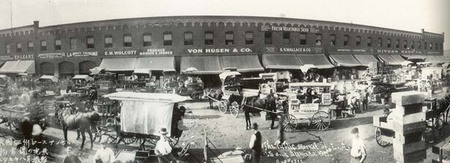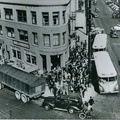Read part 10 >>
DESERTS TO FARMLANDS
Resolved to become
The soil of the foreign land,
I settle down.1
Throughout the Pacific and Rocky Mountain states of America, the Japanese immigrants farmed. In 1909, agriculture was by far the biggest employer of Issei laborers, with more than 38,000 employed as field hands at the height of the harvest. Approximately 95 percent of these Japanese farm laborers worked in California. More than the sum of other races combined, they provided the greatest source of temporary help.
As Toshisaburo Fukuzawa of Kingston, Washington explained, “Farming was not necessarily a steady job. However, it was much steadier than day work in the towns, or on the railroads and in the sawmills. We had to cling to the land in order to live in the foreign country, America.”2
Many of the Issei moved from migrant laborers to contract farming and from share-cropping to cash-leasing or landownership. California was where the Issei independent farmers established themselves in greatest numbers, although the Japanese farmed to a lesser extent in Washington, Oregon, Colorado, Utah, Idaho, Montana, and Texas.
In Northern California, the earliest records indicate that in 1902, 350 Japanese farmed 17,250 acres. By 1910, there was a dramatic increase of 1,816 Japanese farming on 99,254 acres.3 Few farmed on as large a scale as Kinji Ushijima (George Shima), known as the “Potato King,” who turned thousands of acres of tule-covered marshlands in the San Joaquin River delta near Stockton into rich fertile farmland. In 1920, he was reported to own or control 85 percent of California’s potato crop. When Shima died in 1926, his estate was worth $15 million.4
There were other farmers, such as Keisaburo Koda, known as the “Rice King”, who was farming 10,000 acres of crops in Dos Palos, California worth millions of dollar’s on the eve of World War II. However, the majority of Issei were truck farmers who grew vegetables on three to forty acres of leased land. The most successful truck farmers started small scale enterprises in and about the city of Los Angeles, where they took their produce to the public market to sell.
Many Issei went into strawberry growing, which “was the best means in those days to earn a living,” according to Riishi Satow. “It was one of the few things you could get into without big seed money.” Although the plants were productive for only four years, they produced fruit quickly. By 1910, Japanese were producing 70 percent of California’s strawberries.5
“Why should the Japanese wish so strongly to lease land rather than to work for wages?” the Immigration Commission asked in their 1901-10 survey. In response to their own question they concluded that “they controlled the land and worked for themselves in Japan, here they wished to do the same.”6 Moreover, farming offered the Issei the greatest hope for independence and a settled way of life.
Perhaps blood and sweat
Of pioneers has moistened
This fertile valley.
Fresh green rows of strawberries
Reach as far as eye can see.7
AGRICULTURAL COOPERATIVES AND ALLIANCES
The formation of local agricultural cooperatives and alliances had occurred very early in the history of Japanese farmers. Bulk buying, credit extension, and group marketing were some of the more common functions performed. In many cases, these alliances were crucial to the survival of the Japanese farmer.
The Japanese dairy farmers in the White River Valley, Washingtn, got their start by first working in American dairies to gain experience and save money. To start their own dairy, two or three Issei would pool their savings to invest in cows and a large pasture. If the operation was not large enough to employ all the partners, some would work in other dairies or on the railroad. The partnership would remain intact until enough money was saved for all the partners to become independent dairymen.8
Riishi Satow, a former president of the Starwberry Growers’ Association composed of growers from Florin, Oak Park, and Sacramento, described the Association’s early functions: “There used to be a company called the Pacific Fruit Produce, maybe still is, to which our Association sold all the strawberries harvested, and in turn they marketed our Sacramento strawberries around Oregon and Washington states. We borrowed money in advance from them, and then gave the needed growers an advance loan. Later, when the crop was in, their balance was adjusted accordingly. That’s how we operated our business on those days. Otherwise, it was impossible not only to do business, but also to support the day to day like for many growers and their families.”9
By 1918-19, over half of California’s 70,000 Japanese had settled into agricultural
Production occupying 458,056 acres (1 percent of the state’s cultivated land) and producing $53,375,000 (approximately 10 percent) of the state’s total agricultural output.10

The Public Market of Los Angeles, California, 6th and Alameda Streets , August 1916. Gift of Masaru, Shigeru and David Masuoka, Japanese American National Museum (90.40.5)
Notes:
1. Ryufu, Ito, Issei , p. 11.
2. Toshisaburo Fukusawa oral history in Kazuo Ito, Issei , p. 165.
3. In Yuji Ichioka, Issei , op cit., p.150.
4. See Don and Nadine Hata, “George Shima: The Potato King of California," Journal of the West , 25, 1 (Jan. 1986), pp. 55-63.
5. Riishi Satow interview, Issei Christians , p. 44.
6. Sueko Nakagawa, Ito, Issei , p.491.
7. Senate Documents, Vol. 85, part 2, 61st Congr., 2nd Sess., 1909-1910 (Washington, 1911), p. 187, in Kaizo Naka, Social and Economic Conditionbs Among Japanese Farmers in California , Master Thesis, University of California, Berkeley (Berkeley, 1913), p. 23.
8. John Isao Nishinoiri, Japanese Farms in Washington , Master of Arts Thesis (University of Washington, 1926), pp. 34-35.
9. Riichi Satow interview in Michiyo Laing et al. (Eds), Issei Christians , p.44.
10. Calirornia Board of Control, California and the Oriental , (Sacramento, 1920).
Issei Pioneers: Hawai‘i and the Mainland, 1885 - 1924 is the catalogue accompanying the National Museum’s inaugural exhibition. Using artifacts from the National Museum’s collection to tell the story of the courageous “Issei Pioneers,” the catalogue focuses on the early immigration and settlement years. To order the catalogue >>
© 1992 Japanese American National Museum





